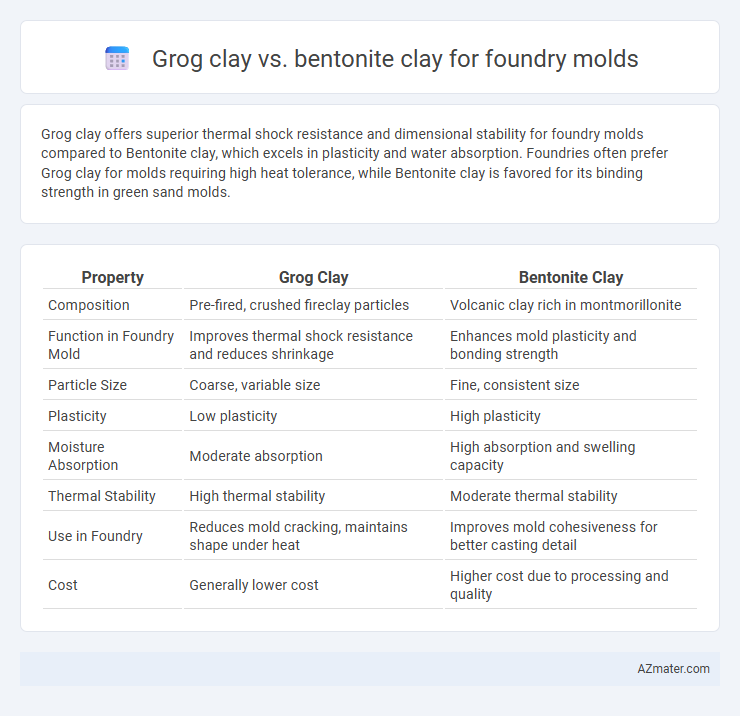Grog clay offers superior thermal shock resistance and dimensional stability for foundry molds compared to Bentonite clay, which excels in plasticity and water absorption. Foundries often prefer Grog clay for molds requiring high heat tolerance, while Bentonite clay is favored for its binding strength in green sand molds.
Table of Comparison
| Property | Grog Clay | Bentonite Clay |
|---|---|---|
| Composition | Pre-fired, crushed fireclay particles | Volcanic clay rich in montmorillonite |
| Function in Foundry Mold | Improves thermal shock resistance and reduces shrinkage | Enhances mold plasticity and bonding strength |
| Particle Size | Coarse, variable size | Fine, consistent size |
| Plasticity | Low plasticity | High plasticity |
| Moisture Absorption | Moderate absorption | High absorption and swelling capacity |
| Thermal Stability | High thermal stability | Moderate thermal stability |
| Use in Foundry | Reduces mold cracking, maintains shape under heat | Improves mold cohesiveness for better casting detail |
| Cost | Generally lower cost | Higher cost due to processing and quality |
Introduction to Grog Clay and Bentonite Clay
Grog clay, composed of pre-fired clay particles, enhances foundry molds by improving thermal shock resistance and reducing shrinkage during metal casting. Bentonite clay, a highly plastic and swelling smectite clay, is valued for its superior bonding properties and moisture retention, ensuring mold stability and fine surface finish in foundry applications. Both grog and bentonite clays play crucial roles in optimizing mold performance, with grog providing structural strength and bentonite enhancing mold cohesion.
Key Differences Between Grog and Bentonite Clays
Grog clay consists of crushed, fired clay particles that improve thermal shock resistance and reduce shrinkage in foundry molds, while bentonite clay is a natural, highly plastic material valued for its strong bonding and water retention properties. Grog enhances mold permeability and prevents cracking during casting, whereas bentonite provides excellent green strength and plasticity, enabling better mold compaction and shape retention. The choice between grog and bentonite depends on the required mold strength, thermal stability, and surface finish quality for specific foundry applications.
Composition and Properties of Grog Clay
Grog clay is composed primarily of crushed fired clay particles, which provide high refractory properties and improve thermal shock resistance in foundry molds. Its coarse, porous texture enhances permeability and reduces shrinkage during mold drying, making it ideal for molds that require dimensional stability and durability. In contrast, bentonite clay, rich in montmorillonite, offers excellent plasticity and bonding but lacks the refractory strength and thermal resilience found in grog clay.
Composition and Properties of Bentonite Clay
Bentonite clay, primarily composed of montmorillonite, stands out for its exceptional swelling capacity and high binding strength, which are critical for maintaining mold integrity in foundry applications. Its fineness and high plasticity enable superior water retention, enhancing mold cohesion and surface finish compared to Grog clay, which is mainly composed of calcined fireclay and lacks the same binding properties. The unique cation exchange capacity of Bentonite clay further improves its durability and reusability in foundry molds, making it a preferred choice for precision casting processes.
Performance in Foundry Mold Applications
Grog clay enhances foundry mold performance by improving thermal shock resistance and reducing shrinkage during metal casting, making it ideal for high-temperature molds. Bentonite clay offers superior plasticity and binding strength, providing excellent mold integrity and surface finish but can retain more moisture, affecting mold drying time. Combining grog with bentonite optimizes mold durability and dimensional accuracy, balancing thermal stability with mold cohesiveness in foundry applications.
Moisture Absorption and Retention Capabilities
Grog clay exhibits lower moisture absorption and superior moisture retention compared to bentonite clay, making it ideal for foundry molds requiring dimensional stability during metal casting. Bentonite clay, while highly absorbent, tends to lose moisture rapidly, potentially causing mold shrinkage and defects. The balance of moisture retention in grog clay enhances mold strength and surface finish quality in foundry applications.
Impact on Mold Strength and Permeability
Grog clay enhances foundry mold strength by providing coarse, refractory particles that reduce thermal expansion and improve dimensional stability, resulting in more robust and crack-resistant molds. Bentonite clay excels in permeability due to its fine particle size and high plasticity, allowing better gas escape during metal pouring and reducing defects such as blowholes. The optimal mold combines grog's structural reinforcement with bentonite's superior permeability, balancing durability with efficient venting for improved casting quality.
Casting Surface Finish: Grog vs Bentonite
Grog clay enhances foundry mold performance by providing a rougher casting surface finish due to its coarse, granular structure, which improves mold permeability and reduces defects like gas porosity. Bentonite clay delivers a smoother surface finish, attributed to its fine particles and excellent plasticity, enabling better mold compaction and surface detail replication. The choice between grog and bentonite influences surface texture and casting quality, with grog favoring roughness and durability, while bentonite optimizes smoothness and precision.
Cost and Availability of Each Clay Type
Grog clay typically costs more than bentonite clay due to its processing requirements but offers superior refractory properties, making it ideal for foundry molds that demand high thermal resistance. Bentonite clay is widely available and more affordable, commonly used as a binder in foundry sands due to its excellent swelling and plasticity characteristics. Availability of bentonite is generally higher globally, while grog clay sourcing may be limited to regions with suitable fireclay deposits, impacting overall project cost and supply chain efficiency.
Choosing the Right Clay for Your Foundry Mold Needs
Grog clay offers superior thermal shock resistance and improved permeability, making it ideal for complex foundry molds requiring durability and precise gas escape. Bentonite clay provides excellent plasticity and bonding properties, ensuring mold integrity and surface finish in less intricate casting processes. Selecting the right clay depends on the mold complexity, thermal requirements, and the desired balance between mold strength and workability.

Infographic: Grog clay vs Bentonite clay for Foundry mold
 azmater.com
azmater.com